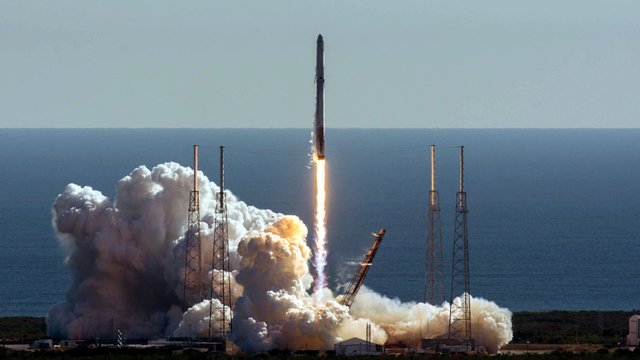SpaceX is known for its reusable rockets, but one under-appreciated technology it has pioneered is letting them self-destruct.
Orbital rockets capable of lifting heavy satellites into space are enormous and dangerous. Flying one from a launch site like Cape Canaveral traditionally requires an Air Force range-safety officer in place, ready to transmit a signal to detonate the rocket safely in the sky if the launch threatens to go awry.
SpaceX, however, pursuing cheaper and more efficient launches, worked with the Air Force to turn over that duty to a GPS-equipped on-board computer, an “Automatic Flight Safety System” that debuted in 2017. Now, if the company’s Falcon 9 rocket goes outside prescribed bounds when launched from Cape Canaveral, it can activate its own self-destruct sequence.
No other US rocket has this capability yet, and it could open up new advantages for SpaceX: The US Air Force is considering launches to polar orbits from Cape Canaveral, but the flight path is only viable if the rockets don’t need to be tracked for range-safety reasons. That means SpaceX is the only company that could take advantage of the new corridor to space.
Rockets at the Cape normally launch satellites eastward over the Atlantic into orbits roughly parallel to the equator. Launches from Florida into orbits traveling from pole to pole generally sent rockets too close to populated areas for the Air Force’s liking. The new rules allow them to thread a safe path southward, past Miami and over Cuba.

Currently, US launches to polar orbit take place at California’s Vandenberg Air Force Base, a less efficient facility for frequent commercial launches. At the Cape, meanwhile, both NASA and Air Force officials have embraced the needs of private rocket-builders like Elon Musk’s SpaceX; Boeing and Lockheed Martin’s joint venture United Launch Alliance (ULA); Orbital ATK, and Jeff Bezos’ Blue Origin. Forthcoming launch vehicles from ULA and Blue Origin are expected to adopt the automatic safety system when they debut in 2020.
SpaceX pushed for the new automated system for several reasons. One was efficacy: The on-board computer can react more quickly than human beings relying on radar data and radio transmissions to signal across miles of airspace, which gives the rocket more time to correct its course before blowing up in the event of an error.
As important, the automated system means the company doesn’t need to pay for the full use of the Air Force radar installations on launch day, which means SpaceX doesn’t need to pay for some 160 US Air Force staff to be on duty for their launches, saving the company and its customers money. That’s just one reason it can underbid its competitors by tens of millions of dollars; the reduced workforce and infrastructure also help the company launch more often.
Most impressively, the automated system will make it possible for SpaceX to fly multiple boosters at once in a single launch. Later this month, the company plans to debut its Falcon Heavy rocket, which is built on three reusable boosters that will fly back to Earth independently after launch. Rather than having safety officers tracking each booster as they attempt to land, each will rely on their automated systems to destroy them if they go off course.
If everything goes as planned, the Falcon Heavy will be the most powerful in the world, capable of launching heavy-duty gear needed for mega-satellites and deep space exploration. It will owe its capability not just to powerful, reusable engines and clever guidance computers, but also to an internal ability to know if its time is up.
Hi, I found some acronyms/abbreviations in this post. This is how they expand: